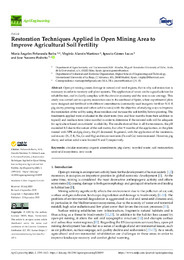Please use this identifier to cite or link to this item:
https://hdl.handle.net/11000/34748Full metadata record
| DC Field | Value | Language |
|---|---|---|
| dc.contributor.author | Peñaranda Barba, Mariangeles | - |
| dc.contributor.author | Alarcon martinez, Virginia | - |
| dc.contributor.author | Gómez Lucas, Ignacio | - |
| dc.contributor.author | Navarro-Pedreño, Jose | - |
| dc.contributor.other | Departamentos de la UMH::Agroquímica y Medio Ambiente | es_ES |
| dc.date.accessioned | 2025-01-16T19:48:21Z | - |
| dc.date.available | 2025-01-16T19:48:21Z | - |
| dc.date.created | 2023-09 | - |
| dc.identifier.citation | AgriEngineering 2023, 1599–1613 | es_ES |
| dc.identifier.issn | 2624-7402 | - |
| dc.identifier.uri | https://hdl.handle.net/11000/34748 | - |
| dc.description.abstract | Open pit mining causes damage in natural and rural regions; that is why soil restoration is necessary in order to recovery soil–plant systems. The application of waste can be a good solution for rehabilitation, and it clearly complies with the circular economy and the zero-waste strategy. This study was carried out in a quarry restoration area in the southeast of Spain, where experimental plots were designed and fertilized with different amendments (commonly used inorganic fertilizer N-K-P, pig slurry, pruning waste and urban solid wastes) with the objective of studying ways to improve the restoration of the soil by using these residues and increase the soil fertility before planting. The treatments applied were evaluated in the short term (two and four months from their addition to topsoil) and medium term (nine months) in order to determine if the restored soils will be adequate for agriculture based on nutrients’ availability. The results showed that in all the treatments, the pH exceeded 8.5 due to the nature of the soil matrix, but after 9 months of the application, in the plots treated with NPK and pig slurry, the pH decreased. In general, with the application of the treatments, soil macro- (N, P, K, Na, Ca and Mg) and micro-nutrients (Fe and Cu) were increased. However, pig slurry and urban solid waste favored N and P, respectively | es_ES |
| dc.format | application/pdf | es_ES |
| dc.format.extent | 15 | es_ES |
| dc.language.iso | eng | es_ES |
| dc.publisher | MDPI | es_ES |
| dc.rights | info:eu-repo/semantics/openAccess | es_ES |
| dc.rights | Attribution-NonCommercial-NoDerivatives 4.0 Internacional | * |
| dc.rights.uri | http://creativecommons.org/licenses/by-nc-nd/4.0/ | * |
| dc.subject | circular economy | es_ES |
| dc.subject | organic amendments | es_ES |
| dc.subject | pig slurry | es_ES |
| dc.subject | recycled waste | es_ES |
| dc.subject | soil restauration | es_ES |
| dc.subject | semi-arid ecosystems | es_ES |
| dc.subject | zero waste | es_ES |
| dc.subject.other | CDU::6 - Ciencias aplicadas::62 - Ingeniería. Tecnología | es_ES |
| dc.title | Restoration Techniques Applied in Open Mining Area to Improve Agricultural Soil Fertility | es_ES |
| dc.type | info:eu-repo/semantics/article | es_ES |
| dc.relation.publisherversion | https://doi.org/ 10.3390/agriengineering5030099 | es_ES |

View/Open:
10.3390agriengineering5030099.pdf
934,79 kB
Adobe PDF
Share:
.png)
